Michael Mikát
Project title: Social evolution in Ceratina bees: a comparative approach
Project Number: 893244
Project Acronym: Ceratina
Official EU portal: https://cordis.europa.eu/project/id/893244
This project has received funding from the European Union's Horizon 2020 research and innovation programme under the Marie Sklodowska-Curie grant agreement No 893244.

Main applicant: Michael Mikát
E-mail: michael.mikat@gmail.com
ORCID: http://orcid.org/0000-0001-5364-7180
Research Gate: https://www.researchgate.net/profile/Michael_Mikat
Affiliation during Ceratina project: Department of General Zoology, Martin Luther University, Halle-Wittenberg, Germany and Department of Biology, York University, Toronto, Canada.
Current affiliation: Department of Zoology, Charles University, Prague, Czech Republic.
Supervisors during the Ceratina project: Professor Robert J. Paxton (Martin Luther University, Halle, Germany) and Associate Professor Sandra M. Rehan (York University, Toronto, Canada)
Duration of Ceratina project: 1.11.2020 – 31.10.2023
Summary of the Ceratina project
Social insects are commonly at high abundance in terrestrial ecosystems, where they play important ecological roles as herbivores, detritivores, carnivores and pollinators. The most impressive are large societies like those of many ants and wasps as well as the honey bee. However, for studying the origins of sociality, insects forming small societies are better models, especially facultative social species, because it is possible to compare between solitary and social strategies within one and the same population. Ceratina bees are excellent model taxa for studying the origins of social behaviour, particularly via the evolution of different types of parental behaviour.
Ceratina bees typically nest within the pith of broken sticks and plant stems. A female firstly excavates a burrow in the pith of a stem and later provisions brood cells therein with pollen and nectar. When provisioning is complete, the mother usually guards immature offspring and, when offspring reach adulthood, she continues to provision them with pollen and nectar. Ceratina bees were traditionally considered to be solitary nesters, but there is growing evidence that most Ceratina species are facultatively social, possessing the ability to form colonies containing two (and sometimes few more) females. In contrast to most other Hymenoptera, Ceratina males can also play a role in caring for offspring; before the start of the Ceratina project, colleagues and I discovered the first case of biparental care in bees in the species Ceratina nigrolabiata. We now know that Ceratina bees exhibit very diverse social and parental behaviours. The genus has additional features that make it suitable for research. Firstly, there are about 400 Ceratina species distributed across all biogeographic regions of the world; therefore, this genus is an excellent taxon for so-called comparative analyses. Secondly, local high population densities together with easy nest processing allow one to gather large datasets in little time.
One goal of the Ceratina project was to perform a comparative analysis of social and parental traits of multiple species of Ceratina bees and infer the evolution of their behaviour. A first step was to generate a high-resolution molecular phylogeny of the genus based on ultraconservative elements, which is prerequisite for interpretation of evolutionary patterns. The next goal was to collect natural history data about Ceratina nests, from which it would be possible to infer social and parental strategies of the studied species. My last goal was to study within-nest relatedness between colony members of facultative social species. Relatedness is considered a key parameter influencing the origin of cooperation between individuals of same species. The combination of all three goals together can help uncover the evolution of sociality in Ceratina bees.
In terms of results, I have successfully collected and sequenced DNA of 170 Ceratina species. These represent 22 of the 23 recognized subgenera, ensuring a comprehensive representation of all main lineages of Ceratina from all biogeographical regions. Sequences were processed using the Phylluce pipeline and analysed by phylogenetic software such as IQ-tree and Astral. The final results (phylogenies) are anticipated in early 2024.
Before the Ceratina project commenced, in-depth studies on the natural history of Ceratina species were predominantly focused on those found in East Asia and North America. Knowledge of tropical species were scarce, although the highest diversity of Ceratina bees occurs in the tropics. The Ceratina project has rectified this shortfall. Currently, my collected dataset arising from the Ceratina project comprises 16,570 nests of Ceratina. Detailed observations on the nesting biology have been recorded for 29 species, each represented by a collection of over 40 nests. This dataset includes data on European species, which I collected partially before start of the project, and data on the nesting biology of tropical species from Bangladesh and Guatemala. The data reveal a high prevalence of facultative sociality among Ceratina bees, a trait observed not only in tropical but also Mediterranean species. While the capacity for social nesting exists, solitary nesting predominates, with social nests comprising less than 10% of nests in most species.
The number of brood cells provisioned is also trait that is highly variable between Ceratina species. On average, nests are provisioned with 6-10 brood. Yet, certain American species from the Zadontomerus subgenus, like C. acantha and C. nuantla, frequently have nests with over twenty brood cells, with extremes surpassing thirty. Conversely, species such as C. loewi typically provision a single brood cell per nest. The strategy of nest protection seems to be linked with the number of brood cells provisioned; species with a higher number of brood cells per nest generally have females that actively inspect and clean the brood cells, safeguarding offspring from excrement and parasites. Furthermore, species demonstrating a higher degree of sociality tend to provision a significantly larger number of brood cells compared to those that primarily nest alone (Mikát and Rehan, 2022).
Throughout the Ceratina project, I have focused on examining relatedness within colonies of species from the European subgenus Euceratina within the Ceratina genus. Mydataset includes relatedness estimates for social nests across six Euceratina species. In these species, reproductive duties are carried out by a single female within multifemale (social) nests, while the other females do not reproduce. This pattern occurs regardless of the degree of relatedness among cohabiting females, meaning nestmates could be unrelated, mother-daughter pairs, or even full sisters. The findings for one of these species, C. albosticta, have already been published (Mikát and Rehan, 2023), with results for the remaining species being compiled for an upcoming manuscript.
I am also in the process of developing a new set of microsatellite loci for Ceratina compacta, which belongs to the Asian subgenus Ceratinidia. This new set is anticipated to be used to genotype all species within the subgenus and possibly even broader taxonomic categories. Through bioinformatic tools, I have identified promising microsatellite loci and have ordered primers for ten loci. The samples needed for this relatedness study were collected during my expedition to Bangladesh.
In conclusion, my project has significantly advanced our understanding of the complex social and parental behaviour within the genus Ceratina, shedding light on its evolution. The evidence of facultative sociality across both tropical and Mediterranean species of Ceratina bees underscores the fluidity and variability of social structures within the genus, challenging previous notions that classified these bees predominantly as solitary. The project is a significant contribution to our understanding of social evolution in a relatively simple social insect group, offering perspectives that could shape future research in evolutionary biology, ecology, and conservation.
Most important outputs of the Ceratina research project:
Research papers
Mikát, M., Rehan, S.M., 2023. Large fitness benefits of social nesting in a small carpenter bee. Behav. Ecol. arad077. https://doi.org/10.1093/beheco/arad077
Mikát, M., Rehan, S.M., 2022. Sociality in the North African small carpenter bee, Ceratina albosticta. Insectes Sociaux. https://doi.org/10.1007/s00040-022-00874-4
Presentations at conferences:
Congress of the International Union for the Study of Social Insects: San Diego, California, USA, July 2022: Presentation: Phylogeny and social evolution of Ceratina small carpenter bees.
8th Conference of the Czech Ecological Society: Brno, Czech Republic, September 2022: Presentation: Polyandrous bee provides extended offspring care biparentally as an alternative to monandry based eusociality.
10th Congress of the International Society of Hymenopterists: Iasi, Romania, August 2023: Presentation: Evolution of parental care and sociality in small carpenter bees (Ceratina).
On-line seminar of the Bee Ecology, Evolution and Conservation group at York University, Toronto: Evolution of sociality and parental care in Ceratina bees. Link to video: https://www.youtube.com/watch?v=RnR2GzlRMAE&t=17s .
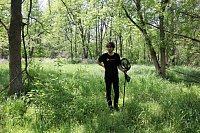
Michael Mikát searching for insects in a forest at Ontario, Canada.
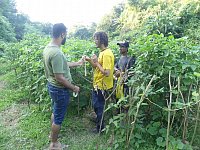
Collecting Ceratina bees in the field in Bangladesh with assistance of local students

Nest of Ceratina (Pithitis) smaragdula. This species is facultative social – it nests either solitarily or socially in the same population. This social nest contains two adult females and three brood cells.
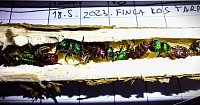
Mature brood nest of Ceratina cf. exima collected during a field expedition in Guatemala
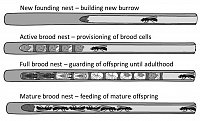
Nesting cycle of Ceratina bees

The fitness benefits of Ceratina albosticta females varies depending on their nesting strategies: females can choose to nest alone or in groups. Social nests may consist of females who are either related (full sisters) or unrelated. In nests shared by two females, one female reproduces (social primary) while the other takes on a non-reproductive role (social secondary). The overall fitness of females is influenced by social interactions and their genetic relationship to one another. Social nests are significantly more productive, resulting in higher fitness benefits for the social primaries compared to the social secondaries. However, the fitness advantages for social secondaries greatly depend on their relatedness to their nestmates. Social secondaries in nests with related females gain substantial indirect fitness benefits from the offspring of their related social primary. Conversely, in nests with unrelated females, social secondaries experience minimal fitness benefits, which might only arise from the possibility of inheriting the nest.
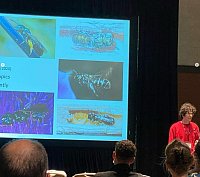
Presentation at the Congress of the International Union for the Study of Social Insects in San Diego, July 2022. Photo Credit: Sandra Rehan

